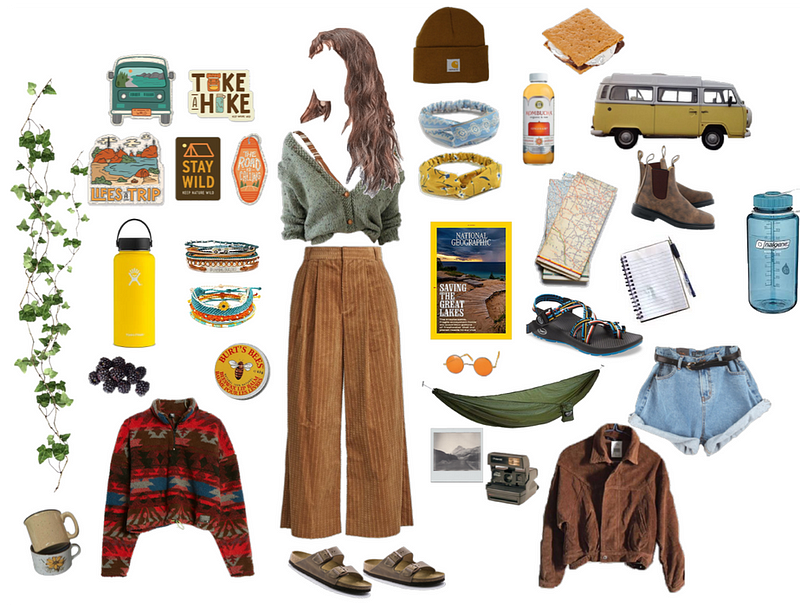
Granola, grunge, light academia — I bet that with each of these words, a slew of correlated images comes to mind. When you think of granola, I bet you envision Blundstones, Chacos, Birkenstocks, a Nalgene water bottle, flat-brim hats and van life. Was I close? When you think of grunge, do you picture heavy eyeliner, baggy clothing and shaggy hair? Most definitely. Does light academia prompt images of trench coats, neutral colors and patterns of tweed and argyle? I am willing to say so. Although we are no strangers to aesthetics, have we internalized them so much as to become immune to individualism? Or, are aesthetics simply more specific ways to identify oneself based on behavior, attitude and self-presentation — no different than writer, sister or athlete?
It is important to note that aesthetics are not inherently bad. Aesthetics first emerged as a way to describe one’s personality and behavior, while offering room for the expansion of pre-existing interests. The granola aesthetic, for example, has flooded social media platforms like TikTok and Instagram and become a convenient hashtag for individuals passionate about spontaneous adventure and the outdoors to seek like-minded individuals. Similarly, if a person enjoys wearing Blundstones, then based on the granola aesthetic one might recommend Birkenstocks. Now, a person has not one, but two solid pairs of shoes. A rather simple example, but it is generally understandable that aesthetics can be perceived as an abbreviated mechanism to expand one’s identity; however, aesthetics come with downsides.
Recently, aesthetics emerged as a mechanism to project highly-curated images of oneself to the world. This is concerning as people are already predisposed to a lack of authenticity. Although aesthetics can be sources of inspiration, more times than not they are used as “catch-all” descriptions for how one should behave, dress and express themselves, exhibiting toxic undertones.
People enjoying particular brands or activities, especially with those that are similar, is not an inherently bad thing. It becomes alarming, however, when they start to shift their identities to fit inside a pre-packaged box. If, for example, a person has been fitting the light academia aesthetic for a few months now but then decides one day to dress more Y2K, they might feel as though the bright colors and graphic tees clash with their pre-established personal brand. There is irony in the thought that humans, as complex as we are, can be boiled down to just a few words. When one propels aesthetic culture forward, they often do so through a conformist lens that inhibits their own individualism, as well as that of others.
Here is an interesting experiment: take out your phone, laptop or whatever the kids are using these days. Do three separate Google searches: granola, grunge and light academia. What do you notice? All the people depicted in the images are slim-figured, white and typically blonde or brunette. The refusal to depict POC individuals as well as varied body shapes and sizes in discussions of aesthetics, once again, epitomizes our conformist society. Instead of talking about what shirt one should wear, aesthetic culture now stigmatizes fixed identities, which perpetuates oppression and inequality.
Aesthetics also exacerbate fast fashion and American consumerism. Stores like Shein, H&M and Forever 21 hinge on a capitalistic model where they put merchandise exemplifying trendy aesthetics in their stores almost as fast as they remove them. If, for example, you go on Shein, there is a section titled “Shop by Style,” which lists Y2K, Preppy and Punk as aesthetics. In a month, the same section might read Cottagecore, Grandmacore and Boho. One can essentially choose an aesthetic for the month, buy all the clothing that fits in with the aesthetic for the time being, and then the fad will eventually diminish. The clothing they had previously acquired will push deeper into their drawers until it is just a distant memory. By comparison, slow fashion companies, like Lucy & Yak or Girlfriend Collective, offer clothing with timeless patterns, colors and fabrics that are not rooted in aesthetics. With all aesthetics, there also comes a point where people reach their peak. They have all the things, they behave the right way and they do it all, but with this reality comes an excessive amount of waste from things one simply does not need.
Despite first emerging as compact descriptors, aesthetics have since molded into tools that force homogeneity and pose dangerous environmental consequences. Although I do not foresee aesthetics going anywhere anytime soon, it is important to remember that as much as one aesthetic might seem appealing or most desirable it is unreasonable and unattainable to put yourself into one box.
















